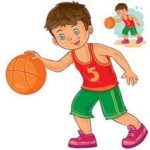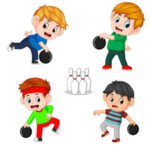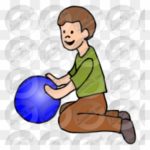
by Santosh | Jun 17, 2020 | Soccer, Sports
LEARNING OUTCOME
To improve dribbling technique
TEACHING CUES
- What part of the boot to use when dribbling (inside, outside, sole)
- Head up / vision / awareness
- Encourage players to use both feet
- Encourage players to increase tempo.
ACTIVITY SET-UP AND PROCEDURE
EQUIPMENT:
- Marked area
- 3 cones
- 1 ball per player
SET-UP:

ACTIVITY PROCEDURES:
- Players dribble around a triangle of cones for 1 minute continuously.
- They can go round in any order or direction.
- Continuous practice.
Progressions:
- Increase the distance between the cones
- Players must incorporate turns and tricks
- Add another player to dribble around the same cones
COOL DOWN/ CLOSURE
Review Skill/Activity, stretching, and questions.

by Santosh | Jun 17, 2020 | Soccer, Sports
LEARNING OUTCOME
To improve dribbling techniques
TEACHING CUES
• Players encouraged to use both feet
• Emphasis is on keeping the ball close to feet and keeping control of the ball
• Encourage players to use tricks and pieces of skill
• Feints/drop shoulder, nutmegs, knock & run, big toe little toe, etc.
ACTIVITY SET-UP AND PROCEDURE
EQUIPMENT:
Cones and 1 ball for each player.
SET-UP:
- Set up the cones in a marked off area, with five on the starting line and four opposite these, as shown. Between cones three and four and seven and eight, place at least four more cones.

ACTIVITY PROCEDURES:
- Dribble the ball from cone one to cone nine.
- Players dribble to cone two and back down to cone three.
- Players then dribble in and out of the cones up to cone four, dribble back to five, up to six and down to seven.
- Players then dribble in and out of the cones up to cone eight and back down to nine, then back to one and start again. 5 laps.
Progressions:
- Encourage players to run at pace
- Mirror the practice and have races
- Time each lap as a target for each player to beat
- Move cones closer together to challenge skills
COOL DOWN/ CLOSURE
Review Skill/Activity, stretching, and questions.
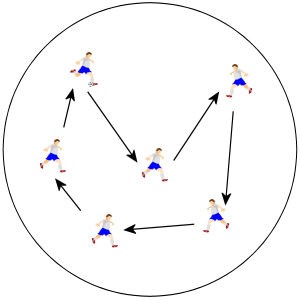
by Santosh | Jun 17, 2020 | Soccer, Sports
LEARNING OUTCOME
To improve passing technique
TEACHING CUES
• Accuracy of pass
• Weight of pass
• Communication
• Vision and awareness of where the pass is coming from and going to
• Direction of 1st touch
ACTIVITY SET-UP AND PROCEDURE
EQUIPMENT:
1 ball between 6 players
SET-UP:
- Marked a playing area
- Give numbers to the players
ACTIVITY PROCEDURES:
- Continuous passing drill.
- Number players 1 to 6.
- Players constantly on the move in different directions in marked area.
- Players pass in the ball number sequence. 1 to 6, progress to 6 to 1.
- Start with a slow tempo.
Progressions:
- 2 touch / 1 touch
- Change distance between players by increasing area
- Increase tempo
COOL DOWN/ CLOSURE
Review Skill/Activity, stretching, and questions.
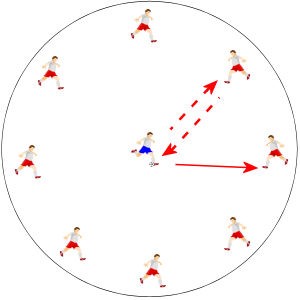
by Santosh | Jun 17, 2020 | Soccer, Sports
LEARNING OUTCOME
To improve the passing technique
TEACHING CUES
- Accuracy of pass, taking in to account distance and angle
- Communication, awareness and vision, be alert
- Decision making, what part of the foot to use, side of boot or laces, etc
ACTIVITY SET-UP AND PROCEDURE
EQUIPMENT:
Marked area, 1 ball for each player
SET-UP:
- Mark a circle
- Players stand on a circle,
- one player stands in the middle and calls for the ball from any player
ACTIVITY PROCEDURES:
- Players make a circle, one player stands in the middle and calls for the ball from any player
- Controls and passes back to the same player then calls for the ball from another player in the circle.
- Middle player repeats play for 1 minute. Then swap middle player.
Progressions:
- Middle player passes back without controlling the ball first
- Encourage players to increase the tempo and use both feet
COOL DOWN/ CLOSURE
Review Skill/Activity, stretching, and questions.

by Neetu | Jun 17, 2020 | Fitness Activity
Posture: Dhanura-asana – The Bow Pose
(Pronunciation: dha-noor-ah-sa-na)
Description:
The Sanskrit word dhanur means bow-shaped, curved or bent. The bow referred is a bow as in “bow and arrow.” This asana is so named because the body mimics the shape of a bow with its string stretched back ready to shoot an arrow.
Performing Instructions
- Lie flat on the back in the shava-asana (corpse pose).
- Lie on the stomach with the head turned to one side and the arms alongside the body with palms facing upward.
- Turn the head and place the chin on the floor. Exhale, bend the knees, reach back with the arms and grasp the right ankle with the right hand and the left ankle with the left hand.
- While inhaling, slowly raise the legs by pulling the ankles up and raising the knees off the floor while simultaneously lifting the chest off the floor. Hold the inhale breath. The weight of the body should be resting on the abdomen.
- Tilt the head as far back as possible. Hold the posture as long as you can comfortably hold the inhale breath.
- Slowly exhale bringing the knees to the floor, release the ankles, slowly bring the legs and arms straight down on the floor and turn the head to one side, assuming the prone posture you began with.
Comments:
The most obvious benefit of the dhanur-asana is that it restores flexibility to the spine. Regular practice will relieve lower back pain and release tension and strain in the upper back and neck area. The alternating stretching and releasing of the abdominal muscles increases blood flow to this area and aids all sorts of digestive disorders and discomforts. Strain or fatigue in the legs is also released after a few repetitions. Extended practice will help develop upper-body strength.
Duration/Repetitions:
The dhanur-asana is either held for the duration of the inhaled or between one and three minutes while breathing gently through the nostrils. Repeat it two or three times.
Variations:
The two variations of the dhanur-asana have to do with the method of breathing and the amount of arch of the back. As one progresses with this asana and is able to hold the posture for a longer period of time, the posture can be held while slow, rhythmic breathing is maintained through the nostrils. As the spine becomes more flexible try drawing the feet closer to the head. Some are able to join the top of the head to the soles of the feet although this is certainly not necessary to accomplish the dhanur-asana.







